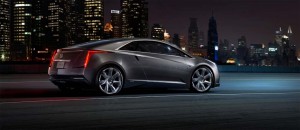General Motors expects to have as many as 500,000 “electrified” vehicles on the road by 2017, says the maker’s global product czar. That will include conventional hybrids, according to Senior Vice President Mary Barra, though the emphasis will be on plug-based models.
The automaker is steadily ramping up sales of various battery based vehicles, though demand has risen at a slower-than-expected pace for its Chevrolet Volt plug-in hybrid. Meanwhile, GM is expected to formally unveil its first pure battery-electric vehicle, or BEV, in more than a dozen years at the upcoming LA Auto Show.
“Plug-based solutions will play a significant role in our technology portfolio going forward,” said Barra during a presentation of GM’s battery-electric strategy. While some of the new products under development will help GM meet government mandates, she stressed, “we’re not building (them) to check a regulatory box.”
GM has had a long-running love-hate relationship with battery power. It meet a 1990s Zero-Emissions Vehicle mandate set by California regulators with the EV1 battery car, but while that vehicle initially drew raves, GM was pilloried when it pulled the EV1 from production and took the remaining vehicles back from lease customers.
In a surprise move, the maker revealed a concept version of what it billed as an extended-range electric vehicle that became the Chevy Volt. Initial sales, after it came to market in late 2010, fell well short of expectation, and though demand has risen almost exponentially this year, Volt is expected to again miss its 2012 target of 45,000 sales in the U.S.
Nonetheless, Barra and other officials contend they’re pleased with the plug-in hybrid’s performance and expect it to continue building momentum. The maker has added a second, European version dubbed the Opel Ampera and a luxury variant, the ELR, will be launched by Cadillac in 2013.
At the current pace, the executive said, GM is selling “over 50,000” electrified vehicles annually.
The coming model-year will also see GM get back into the battery-electric segment for the first time since the EV1 was pulled from production in 1999. As TheDetroitBureau.com yesterday reported, the Chevy Spark EV will be a battery-powered variant of the Spark minicar. With a range expected to come in at just under 100 miles, company officials claim it will be one of the highest-range offerings in the market, well ahead of the Nissan Leaf and Ford Focus EV – though also well behind the new Tesla Model S sedan.
(For more on the Chevrolet Spark EV, Click Here.)
The Chevy Spark EV will make its public debut at the LA Auto Show later this month. That event will see a wide range of new electrified offerings unveiled, including the Honda Accord PHEV and two more plug-ins from Ford, the Fusion Energi sedan and the C-Max Energi microvan.
GM product chief Barra declined to provide an estimate of how sales will break out among the various forms of electrified products if the maker meets its 500,000 sales target. But while conventional hybrids clearly will be an important part of the portfolio, Barra suggested plug-ins, whether extended-range offerings like the Chevy Volt and Caddy ELR, or full battery-electric models like the Spark EV, will be the primary focus.
And GM is by no means alone. During a conference in Washington, D.C. this week, Renault/Nissan Alliance CEO Carlos Ghosn said the two companies expect to have capacity in place to produce more than 500,000 battery cars annually by mid-decade, there with an emphasis on full battery-electric propulsion, as in the current Nissan Leaf. That maker will launch production of Leaf at a second plant, this one in Tennessee, late this year.
In his speech, Ghosn stressed that building demand for electrification will be a challenge, urging that, “There must be some kind of vision, policy about energy.
For her part, Barra declined to specifically discuss government’s role, sidestepping the issue of whether the push for battery power might require an increase in federal incentives; now as much as $7,500 for a vehicle like the Chevrolet Volt or Spark models, President Obama wants to increase the tax credits to $10,000.
But Barra did conclude that, “General Motors’ push will be to work with government cooperatively.”

